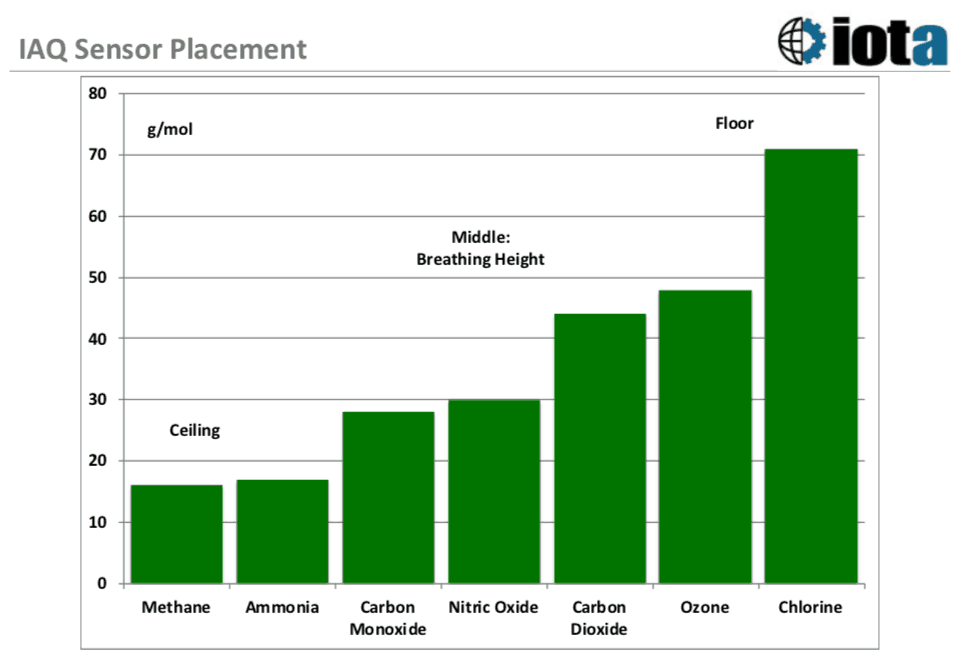To be honest, few of the facilities managers who use our indoor air quality monitoring service came to us for that reason. More often than not they were initially interested in remotely monitoring some other aspect of their buildings, such as energy use, in an effort to cut costs. It wasn’t until later, as they continued working with us, that they learned about and implemented indoor air quality monitoring to provide a healthier, safer building environment—and to head off the negative consequences associated with indoor air pollutants.
Like many facilities managers, you, too, might be overlooking the significance of the air quality inside your building. But just because you can’t see it doesn’t mean it should be dismissed. Studies have shown that poor-quality indoor air has a major impact on humans:
- Approximately 3.8 million people around the world die every year as a result of indoor air pollution.
- Particulate matter is the cause of numerous respiratory ailments including asthma, respiratory inflammation, decreased lung function, and cancer.
- Low-quality air reduces human productivity and our ability to process information.
Thanks to issues like these, indoor air pollution is consistently ranked as one of the top five environmental risks to public health.
And the issue isn’t necessarily going unnoticed—one report notes that 24% of office workers questioned at random reported air quality problems in their workplace, and 20% believed it was harming their ability to do their job effectively. They’re not wrong: The EPA estimates that poor indoor air quality affects 33% to 50% of commercial buildings in the U.S. and is responsible for over 10 million lost work days per year. The impact of a “sick building” could, in some cases, extend all the way to the bottom line, particularly if it prompts a lawsuit and/or negatively impacts marketability.
[bctt tweet=”The EPA estimates that poor indoor air quality affects 33% to 50% of commercial buildings in the U.S. and is responsible for over 10 million lost work days per year.” username=”iotacomm”]
All this leads to some important questions: How do you test indoor air quality? And how can you improve indoor air quality should testing reveal a need for it?
This article answers those questions, and provides some additional context around indoor air quality standards, best practices, monitoring equipment, and more.
How can you improve indoor air quality? Start by understanding what “good” air quality means.
Indoor air quality monitoring is all about achieving a healthy indoor environment, but what does that really mean? In general, it means:
- There is adequate ventilation (the introduction and distribution of clean air).
- Contaminants are controlled.
- The temperature and humidity level are comfortable.
Adequate Ventilation
Ventilation plays an important role in indoor air quality. According to the EPA, ventilation is a “combination of processes which results in the supply and removal of air from inside a building.” Those processes include bringing in outside air, conditioning it and mixing it with indoor air, distributing that air throughout the building, and moving some portion of indoor air outside. If one or more of these processes are underperforming, the quality of indoor air will be affected.
Many commercial buildings use mechanical ventilation—fans and ductwork—that are part of the heating and HVAC systems. Some buildings can also utilize natural ventilation by opening doors or windows. The “ventilation rate” is the amount of outdoor air introduced into a space per a unit of time, and is often expressed in cubic feet per minute (cfm). You can find the ASHRAE (American Society of Heating, Refrigerating and Air-Conditioning Engineers) minimum ventilation rates for acceptable air quality online.
Contaminants To Control
Many pollutants that impact indoor air quality come from sources inside a building, though some are drawn in from outdoors. Among the most common pollutants are:
- Volatile organic compounds (VOCs)—These are the main contributors to poor indoor air quality; they are ubiquitous both indoors and outdoors. VOCs are organic chemicals emitted as gases from products or processes; for the most part, you can smell their presence. Typical sources of VOCs indoors include things like cleaning agents, disinfectants, air fresheners, dehumidifiers, and more. (Even something as seemingly innocuous as a new carpet is likely to be giving off formaldehyde gas.) Sources of VOC contamination from outside could include volatile chemicals in polluted groundwater that are pulled inside during water use.
- Carbon monoxide (CO)—In contrast to VOCs, carbon monoxide is impossible to smell, taste, or see. At low and moderate concentrations it could cause fatigue, chest pain, or impaired vision; at high concentrations it could be fatal. Sources of carbon monoxide are generators, poorly maintained boilers or furnaces, automobile exhaust from nearby idling vehicles, and more.
- Particulate matter (PM)—Found both inside and outside, particulate matter is a mixture of solid particles and liquid droplets suspended in the air, such as dust, pollen, smoke, and soot. The particles themselves are different sizes, but the ones to be most concerned about are the smallest—10 micrometers in diameter or smaller—because they can be inhaled. Inhalation of PM can affect the heart and lungs. Outdoor PM, generated by construction, for example, or the burning of fossil fuels, enters into buildings via natural and mechanical ventilation. Indoors it can be produced by fireplaces, cigarette smoking, or other activities.
Some other pollutants to consider (but not a definitive list) are:
- Radon
- Carbon dioxide
- Nitrogen dioxide
- Methane
Temperature/Humidity Levels
Temperature and humidity are considered important elements of air quality by the EPA, in part because of comfort. But too-high temperature and humidity levels have other consequences as well. Mold can begin to form as a result of high humidity; also, the rate at which chemicals are released from building materials is usually higher at higher building temperatures.
Indoor temperatures are sometimes more challenging to control than they seem due to factors such as heat gains from sunlight, outdoor conditions, and the outdoor air ventilation rate. ASHRAE recommends temperatures ranging from 68.5 to 75 degrees Fahrenheit in the winter, and from 75 to 80.5 degrees in the summer; indoor relative humidity should be maintained at or below 65%. The EPA recommends humidity levels of between 30% and 60% to reduce mold growth.
How To Test Indoor Air Quality
Once you understand the goal of indoor air quality monitoring, the question becomes, “How can you measure indoor air quality?”
Many companies offer indoor air quality monitoring equipment that can help you measure the levels of specific pollutants. It all starts with sensors.
Wondering how you can measure indoor air quality in a cost-effective way? See if our monitoring service is a good fit for you.
Indoor Air Quality Sensors
Sensors are devices used to detect some type of input in the physical environment—for example, light, motion, temperature, etc.—and transmit that information into a signal that can be measured and transmitted electronically. In this case, an indoor air quality sensor would detect the presence of a particular pollutant.
Different types of sensors measure different things. Advanced technology has brought down the cost of indoor air quality testing by creating smaller, less expensive sensors; you’ll need enough to place them strategically throughout your building to produce reliable results. (The EPA recommends one sensor for every 10,000 square feet.) Core categories for sensor measuring are:
- Carbon monoxide
- Particulate matter
- VOCs
- Humidity
- Formaldehyde
- Radon
Sensors are also capable of measuring methane, bioaerosols, and more; depending on your specific concerns and the activities taking place within your building, it may be appropriate to measure additional pollutants beyond those listed above.
An Added Benefit Of Monitoring CO2: Reducing Energy Waste (& Saving Money!)Carbon dioxide (CO2) may not be the most pernicious factor impacting indoor air quality, but it is often used as a surrogate for air quality and building occupancy level. The more occupants there are in a room or building, the more CO2 is released into the air. To prevent CO2 levels from rising too high—which can have a negative impact on occupants—outside air must be deliberately brought into the building through a ventilation system. Often, however, those efforts unnecessarily overwork the ventilation system, wasting energy. By monitoring CO2 levels and providing ventilation on an as-needed basis—called demand control ventilation—you can maintain healthy air quality and reduce your energy use. Read about how much you could save with demand control ventilation here. |
Sensor Placement
Sensors are typically placed throughout a building in the common areas, usually not directly located near induction units, floor fans, or personal heaters, and out of direct sunlight. A wall mount is best, as floors and ceilings may not be indicative of the actual environment.
When mounting a wall sensor, consider the height at which they should be placed. Most commonly they are mounted at height-level or slightly lower, if people primarily remain seated in that particular area. However, the molecular weight of some substances makes them gravitate toward the floor or ceiling; depending on what pollutant you’re trying to track you’ll need to place the sensor accordingly. For example, as you can see on the chart below, methane is lighter than air and so the highest concentrations inside buildings are usually near the ceiling. Conversely, ozone is heavier than air and remains near the floor.

*Parameters are measured in grams per mole
Not all sensors work the same way; ours take a sample of the air every 15 minutes. If you’re working with an Internet of Things company like Iota, your indoor air quality monitoring equipment will send the sensor data to the cloud, where you can access it via software. You get immediate, real-time access to the monitoring results via a dashboard, which turns the data into visual charts that are easy to decipher.
As you continue monitoring over time, the data you receive will paint an accurate picture of your building’s overall air quality. Once you understand that, you’ll have the information you need to move forward: Are the conditions such that you need to take corrective action to control certain pollutants? Or will you be working to maintain your current conditions, which are within the recommended parameters? Below are some of the recommended parameters for indoor air quality as noted by the International Well Building Institute:
| Characteristic | Conditions To Be Met |
|---|---|
| Particulate Matter | 10 micrometers or less in diameter: 50 ug/m3; 2.5 micrometers or less in diameter: 15 ug/m3 |
| Carbon Monoxide | Less than 9 ppm |
| VOCs | Less than 500 ug/m3 |
| Formaldehyde | Less than 27 ppb |
| Carbon Dioxide | About 700 ppm above outdoor air levels (usually about 1,000 to 1200 ppm) (ASHRAE) |
| Humidity | Below 60%, ideally between 30% and 50% (EPA) |
| Temperature | 68.5°F to 74°F (winter); 75°F to 80.5°F (summer) (ASHRAE) |
*ug/m3 = micrograms per cubic meter
In addition to getting the “big picture” of your indoor air quality, an indoor air quality monitor can be set up to provide threshold alerts. If, for example, the outside air has a CO2 level of 400 ppm, you could set up your monitoring equipment to alert you when indoor levels reach 950, and when the air has reached critical point at 1100 ppm. From there you can take the appropriate action to resolve the situation immediately.
How can you improve indoor air quality?
There is no single prescribed method for improving indoor air quality. The approach you’ll take may depend on a number of factors, including your individual building, the outdoor environment, and the extent of the problem.
Sometimes a temporary indoor air quality problem is created simply by a one-off, out-of-the-ordinary activity taking place inside a room or building, such as an overcrowded meeting area. In those cases, a short-term fix may be all that’s needed, such as opening a window or bringing in a fan. But more complex issues—identified by consistently unacceptable air quality monitoring results—will require a different tack. Depending on the issue you’re experiencing, one of the three tactics below may be appropriate.
Keep in mind that the right approach to addressing the issue isn’t always clear at the outset; therefore, it may be helpful to deploy more sensors to get a better understanding of the problem before investing time and resources in attempting to solve it.
1. Control The Source
Controlling the source of a pollutant is usually the most effective (and cost-effective) approach to improving air quality when a particular source can be identified. Some examples:
- Installing a “low-VOC” carpet can help reduce your VOC level.
- Moving contaminant-producing equipment to a better ventilated space can help dilute the contaminant.
- Covering formaldehyde-emitting materials and supplies helps contain the pollutant.
2. Improve Ventilation
Increasing the amount of outdoor air coming indoors is another effective approach (though it doesn’t work in every case). A building’s ventilation system is made up of ducts and fans that carry stale air outdoors and mix recycled return air with outside air and bring it indoors. Problems sometimes arise with mechanical ventilation units that lead to indoor air quality problems.
For example, contaminants may collect within the air diffusers and grills, introducing pollutants into the environment. Or if the outdoor air intake is located near a source of moisture or other outdoor pollutant, it may serve as a pathway to carry the contaminants inside. Or the ventilation system may not be working as well as it should—if debris is blocking the outdoor air intake, for instance, or the filters are contaminated or poorly maintained.
A thorough check of your ventilation system will reveal if one of the above named problems exists and if it’s contributing to the pollutant problem you’re trying to address.
3. Clean The Air
When it comes to commercial buildings, air cleaning tactics are usually most effective when combined with either one of the other strategies listed above—except in cases where the source of pollution is outside the building.
Most air cleaning approaches are designed to remove particulates. For example, some cleaning systems collect pollutant particles from the air using electrostatic force, called electrostatic precipitation. (Charged particles are collected by a strong electric field generated between oppositely-charged electrodes.) Others trap and remove particles using a filter (called particulate filtration).
Want to test your building’s indoor air quality? Talk to us.
At Iota, we can get you started on the road to creating a healthier, comfortable, and more productive building environment for your tenants or employees.
Our line of IoT sensors allow you to remotely monitor a variety of air quality characteristics, and our dashboard—accessible to you anytime, from anywhere—provides visual insight into your building’s environmental conditions. We’ll also help you decipher all that data, and offer recommendations about ways you can minimize pollutants and improve your building’s overall air quality. To find out more about Iota’s indoor air quality monitoring system and how it might work for you, contact us—we’d love to help.


